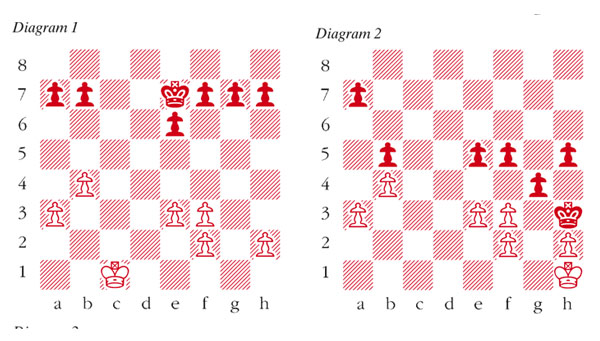In contemporary high-class tournament play both adjournments and early draws have been banned. This is partly due to the accessibility of computer analysis and partly to the realisation that well-remunerated grandmasters have an obligation to entertain. As a result, more and more games are being decided in seemingly level endgames which in former times might have been abandoned as draws. Carlsen is a particular exponent of this attritional warfare.
If it pays to study the endgame, then Akiba Rubinstein is your man, possibly the greatest endgame artist of all time. Rubinstein was active from around 1907 to 1930, during which period all of the great names succumbed at one time or another to his endgame prowess.
Cohn–Rubinstein: St Petersburg 1909; Queen’s Gambit Accepted
1 d4 d5 2 Nf3 c5 3 c4 dxc4 4 dxc5 Qxd1+ 5 Kxd1 Nc6 6 e3 Bg4 7 Bxc4 e6 8 a3 Bxc5 9 b4 Bd6 10 Bb2 Nf6 11 Nbd2 Ke7 12 Ke2 This position is, of course, completely equal. 12 … Be5 13 Bxe5 Nxe5 14 Rhc1 Rac8 15 Bb3 Rhd8 16 Nc4 Nxc4 17 Rxc4 Rxc4 18 Bxc4 Ne4 Black now has a tiny advantage as his knight is quite annoying for White, e.g. 19 Bd3 Nxf2. 19 Ke1 Bxf3 20 gxf3 Nd6 21 Be2 Rc8 22 Kd2 Nc4+ 23 Bxc4 Rxc4 24 Rc1 White should have played 24 f4 (preventing … Rh4) 24 … b5 25 Kd3 with good drawing chances. Cohn, however, assumed that the pawn ending was the simplest way of securing this result. 24 … Rxc1 25 Kxc1 (see diagram 1) 25 … Kf6 Rubinstein, an outstanding master of the endgame, begins an attack on the h2-pawn, which proves decisive. 26 Kd2 Kg5 27 Ke2 The counterattack on the queenside is too slow: after 27 Kd3 Kh4 28 Kc4 Kh3 Black has time to pick up the h2-pawn and queen his own h-pawn. Here it is important only that in reply to Kc7 he should play … b7-b5. 27 … Kh4 28 Kf1 Kh3 29 Kg1 The white king is tied to the defence of the h-pawn. He is powerless against the impending black pawn offensive on the kingside. 29 … e5 30 Kh1 30 a4 b6 31 b5 was more tenacious, when Black would have won by 31 … f5! 32 Kh1 g5 33 Kg1 h5 34 Kh1 h4 35 Kg1 e4 36 fxe4 fxe4 37 Kh1 Kg4 38 Kg2 h3+ 39 Kg1 Kf3 40 Kf1 g4. 30 … b5 Now Black also has an extra reserve tempo ( … a7-a6), which may prove useful. 31 Kg1 f5 32 Kh1 g5 33 Kg1 h5 34 Kh1 g4 (see diagram 2) 35 e4 If 35 fxg4, according to Averbakh, the simplest is 35 … fxg4! 36 Kg1 e4, then 37 … h4 and 38 … g3! 35 … fxe4 36 fxe4 Or 36 fxg4 hxg4 37 Kg1 e3 38 fxe3 e4 39 Kh1 g3. 36 … h4 37 Kg1 g3 38 hxg3 hxg3 White resigns 39 fxg3 Kxg3 and the black king runs along the third rank from h3 to the queenside.





Comments